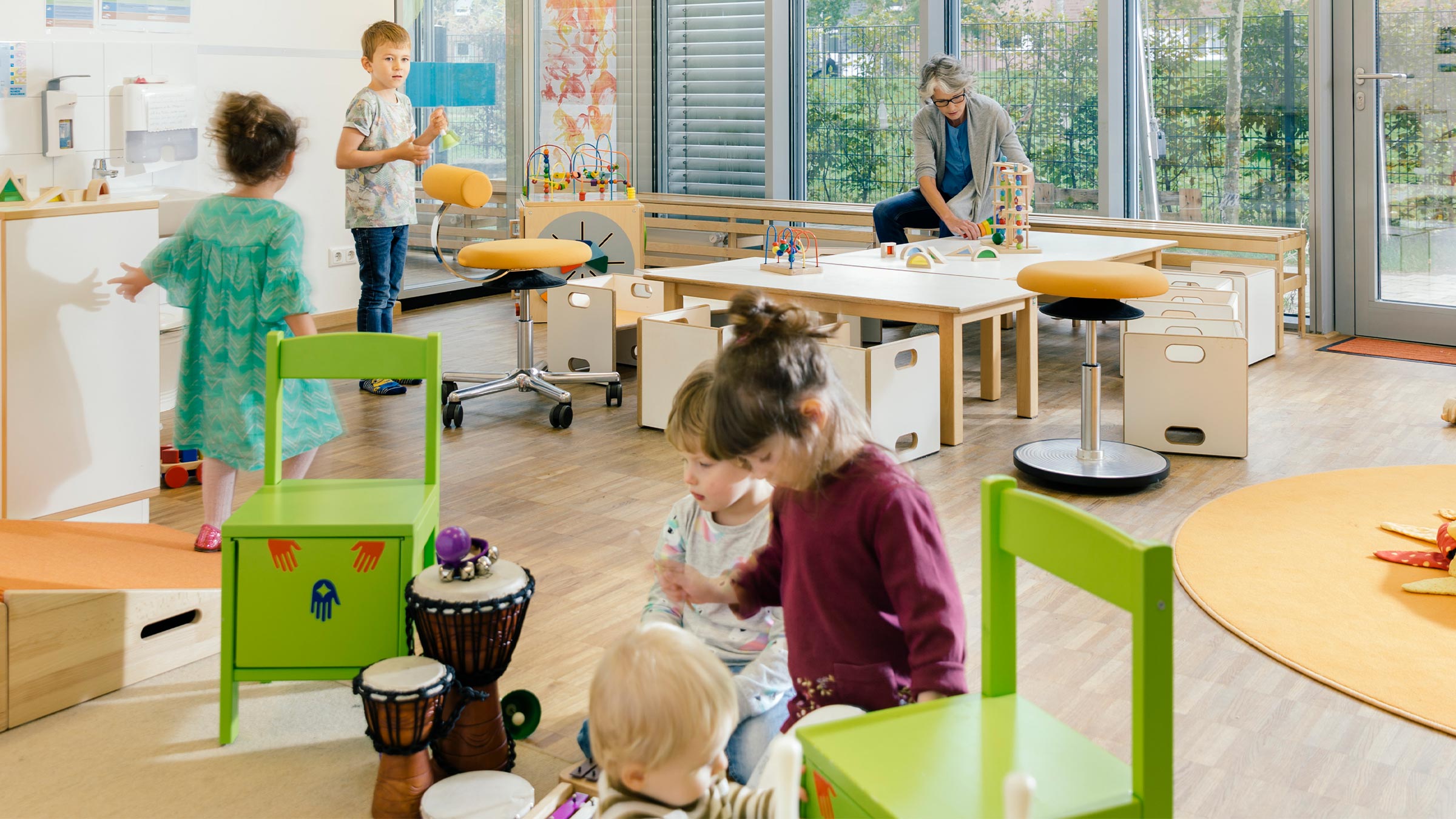At the end of 2024, the capacity of licensed child care providers grew in half of Ninth District states and shrank in the other half, according to data compiled by the Minneapolis Fed.
That means the maximum number of children those providers may care for has continued to diverge. Capacity in North Dakota, South Dakota, and Michigan’s Upper Peninsula has continued to grow. In Minnesota and northwestern Wisconsin, it has continued to decline.
Demand for child care has followed a different path. The number of children with all available parents working, a common measure of demand, has trended downward in all district states. As a result, child care supply is catching up with demand or at least keeping pace, even in places where capacity is shrinking.
While this suggests that the availability of child care is not worsening, affordability is a different matter. The data show that options for families seeking more affordable care have narrowed as the mix of child care providers changes. Small, usually home-based “family child care” providers (FCCs), which usually offer lower tuition, are declining nearly everywhere. Child care centers (CCCs), which usually charge higher tuition, are replacing them.
As many economic development experts have noted, child care plays a crucial role in the region’s labor force. It’s more difficult for parents to work full time or at all when care is not available or affordable.
Diverging child care capacity
Over the past 10 years, licensed capacity in Minnesota and northwestern Wisconsin consistently shrank (Figure 1). In contrast, capacity in Montana, North Dakota, and South Dakota grew in most years.
An asterisk needs to be added to South Dakota’s data, however. The state doesn’t regulate many smaller FCC providers that other states would, so its licensing data reflect mostly CCCs. Census Bureau business surveys reveal that South Dakota FCCs have declined rapidly as well. When these unlicensed FCCs are included, the state’s child care capacity shows more ups and downs.
Overall, what sets those states with growing capacity apart from states with shrinking capacity is the speed at which CCCs can expand into the market vacated by FCCs. Northwestern Wisconsin’s capacity shrank, for example, because it’s the only Ninth District state where CCC capacity shrank. Why states differ in this way is not clear; there are even differences among different areas of each state.
Licensing records in some states were not available for all years requested by the Minneapolis Fed because of changes to licensing software. Michigan, for example, changed its software in September 2023 and had difficulty retrieving earlier records. The Minneapolis Fed used state data compiled by Michigan State University and others, which show an increase in child care capacity in Michigan’s Upper Peninsula.
Slowing demand for child care
While anecdotes abound throughout the Ninth District of parents being unable to find child care, demand has been slowing for years, with demand in some states slowing faster than in others. The last state to enter decline was Minnesota, starting in 2019.
A common metric for demand is the number of children 5 and younger with all available parents in the labor force. In most of the Ninth District and nationwide, this number has fallen (Figure 2), according to the Census Bureau. In fact, the number of all children in that age group, regardless of whether their parents are working, has trended downward.
In most states, the shrinking number of children with working parents means there are more child care slots per child (Figure 3). For example, capacity in Minnesota fell by 3 percent between 2019 and 2023, the fastest of all states in the district. Demand shrank even faster, falling by 8 percent. As a result, the number of slots per child grew from 0.73 to 0.77.
Rural and urban areas in each state tend to follow similar trends even though the gap between supply and demand is usually wider in rural areas.
Note that “slots per child” as a metric has some limitations.
First, licensing data usually do not include breakdowns by age groups, obscuring the different supply-demand dynamics of each age group. Anecdotes from parents and providers suggest the shortage of infant care is severe and growing in many areas in contrast to care for preschoolers. Many providers say the reason is that preschool care is profitable and infant care is not. More public schools are also providing preschool care, increasing supply.
Second, states vary in whether they license child care programs at public schools, making state-to-state comparisons less meaningful. For example, Michigan public schools with child care programs are licensed as CCCs. But, unlike most true CCCs, which serve young children year-round, many of the public-school programs in Michigan operate only during the school year. One recent dataset revealed that school-year programs accounted for a third of the total capacity in Michigan’s Upper Peninsula in 2024. This breakdown was not available for other years. Without the school-year programs, capacity in the Upper Peninsula would be just a bit higher than northwestern Wisconsin.
Changing mix of providers
While supply may, in theory, be keeping pace with demand, the supply of lower-cost child care offered by FCCs has decreased across the Ninth District.
FCC and CCC are standard industry terms representing distinct business models and legal requirements. State regulations may use different terms and some states split FCCs and CCCs into subgroups.
FCCs are almost always home-based businesses with an owner and sometimes a co-owner or an assistant. They’re usually easier to open for those new to the child care business, because regulations are less stringent and using their own home limits start-up costs. But the capacity of individual FCCs is small because of legal requirements governing the amount of space per child and teacher-student ratios.
CCCs are more diverse, with locations ranging from strip malls to church basements, and the number of teachers ranging from a handful to dozens. Providers face stricter regulations and higher costs that may include rent and competitive wages.
For parents, these different business models usually result in lower tuition at FCCs. The differences can be dramatic. Child Care Aware of America’s 2024 price survey revealed that infant tuition at CCCs nationwide was 29 percent higher than at FCCs. In the Ninth District, this gap ranges from 21 percent in North Dakota to 108 percent in Minnesota. The gap narrows for older children.
In most district states, CCCs are the biggest and fastest growing contributor to child care capacity (Figure 4). In Montana, North Dakota, and South Dakota, their numbers have increased by more than 10 percent since 2019. In Minnesota, the average capacity of each CCC has grown even if the number of CCCs has changed little. In Wisconsin, CCC capacity and numbers shrank.
Child care capacity of family child care providers and child care centers
Sources: Minnesota Department of Children, Youth, and Families; Montana Department of Public Health and Human Services; North Dakota Department of Health and Human Services; U.S. Census Bureau County Business Patterns and Nonemployer Statistics; South Dakota Department of Social Services; Wisconsin Division of Early Care and Education; Michigan State University.
Except in Michigan, FCCs continued to lose ground throughout the district, even in rural areas where they tend to be more resilient. They have lost the most ground in Minnesota and North Dakota where their numbers have declined by more than 20 percent since 2019. This loss has hurt overall capacity in Minnesota more than other states, because FCCs make up a larger share of Minnesota’s capacity.
As of 2023, FCCs contribute as little as 10 percent of capacity in Wisconsin and as much as 47 percent in South Dakota.
These child care trends bear watching because, among other things, the industry plays a crucial role in today’s labor market. Without access to affordable care, it’s much harder for parents to participate fully in the labor force, affecting family income and employers struggling with hiring.
Access Ninth District child care licensing data gathered by the Minneapolis Fed.
Tu-Uyen Tran is the senior writer in the Minneapolis Fed’s Public Affairs department. He specializes in deeply reported, data-driven articles. Before joining the Bank in 2018, Tu-Uyen was an editor and reporter in Fargo, Grand Forks, and Seattle.






